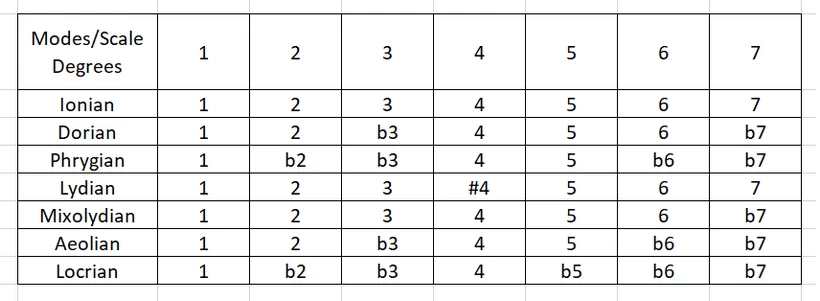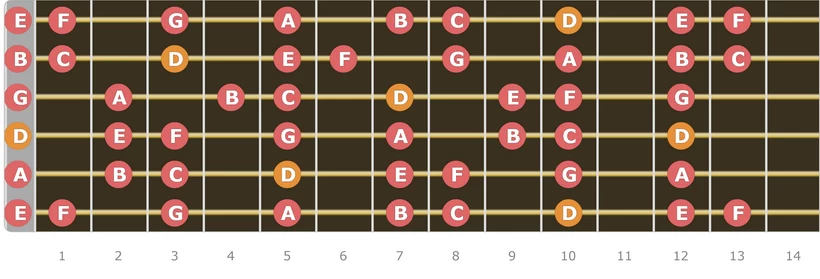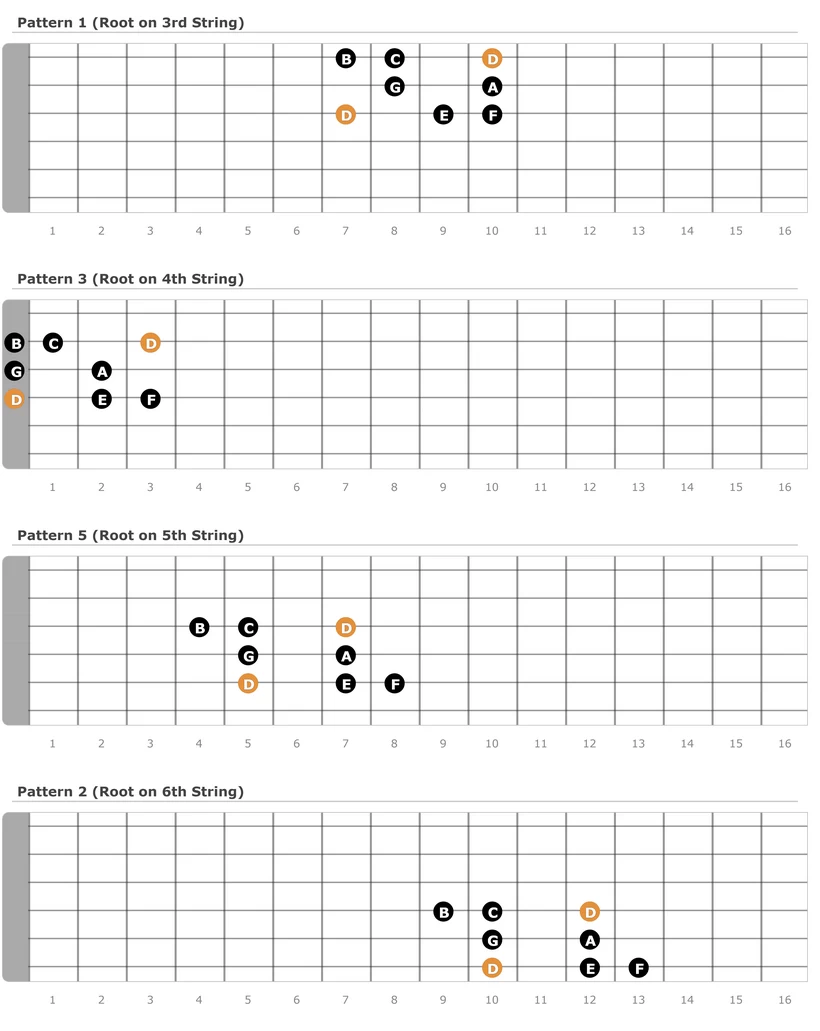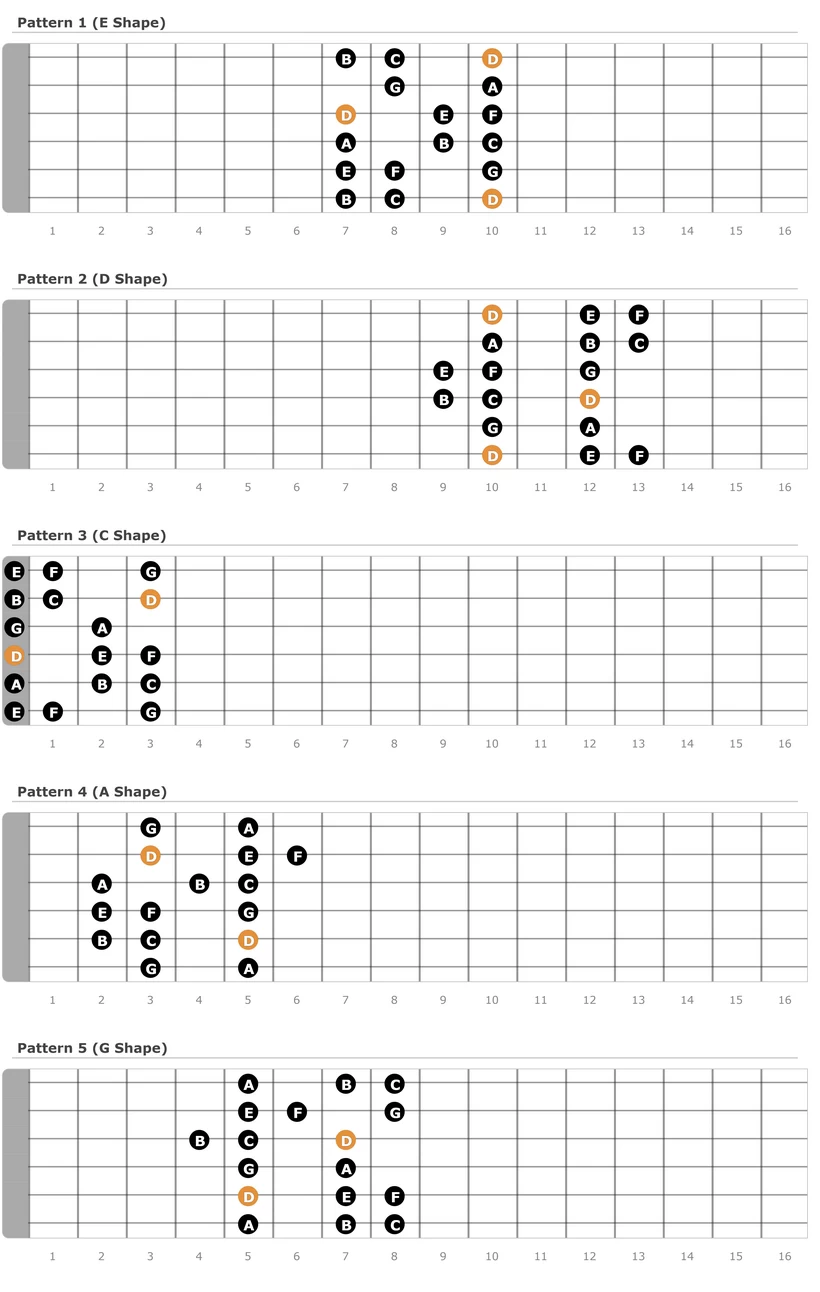So you have decided to learn the modes of the major scales. These different modes give you opportunities to add variety to your music and allow you to borrow the chords from the parallel modes, known as the mode mixture.
In this article, we will cover the Dorian mode in detail – including its formula, intervals, notes, main characteristics, comparison with other modes & scales, possible alterations on them, their patterns on the guitar fretboard, chords, common chord progressions, its use in popular music, etc.
Read the complete article to know all about the Dorian mode and more!
What is a Mode in Music?
Also known as the modal scales, the modes are derived from any scale by starting at a different scale note, keeping the number of notes and their pitches the same as the original scale.
To understand the concept with an example, consider the C major scale with notes [C D E F G A B]. As there are seven notes, you can form seven modes of this scale starting with C, D, E, F, G, A, and B using only these seven notes of the C Major scale. These will be known as the seven modes of the C major scale. The original C major scale starting with C is also a mode of itself, the first mode.
Each major scale mode has a specific name in the music theory. All the modes are scales in themselves. The seven modes of the C Major scale with their notes and the specific names are shown below.
C Ionian mode – [C, D, E, F, G, A, B]. This mode, with its intervals, is known as Ionian. Since it is currently beginning at C, it is named the C Ionian. Its intervals are the same as those of a major scale.
D Dorian mode – [D, E, F, G, A, B, C]. It has its tonic at the second degree of the major scale.
E Phrygian mode – [E, F, G, A, B, C, D],
F Lydian Mode – [F, G, A, B, C, D, E],
G Mixolydian Mode – [G, A, B, C, D, E, F],
‘A’ Aeolian Mode – [A, B, C, D, E, F, G], and
B Locrian Mode – [B, C, D, E, F, G, A],
While the notes of the different modes shown above are the same, the intervals of the notes from their tonic in any mode are different. This results in a different feel and sound for all the modes.
The notes for each mode relative to the major scale are shown in the table below. This means that if you prepare a formula for the notes of C Dorian mode, the changes required in the notes of the C major scale (C Ionian) are listed.

Note that the Aeolian mode forms the natural minor scale, and A Aeolian is the relative minor of the C Ionian. You may see more details about the different modes in our detailed article on the Diatonic modes.
What is the Dorian Mode
You have seen above that the second mode of the major scale is termed the Dorian mode. In the key of C, the D Dorian mode, also known as the D Dorian scale, starting at D, is the second mode.
Similarly, in the key of D, E Dorian forms the second mode. You can see the scale or the mode formula, intervals, notes, and characteristics of the Dorian mode in the following sections.
Dorian Mode Formula
The scale formulas for the Dorian modes, starting with the tonic note, are given below
{W H W W W H W} or {T S T T T S T} or {2, 1, 2, 2, 2, 1, 2}
The three formulas shown are in terms of the W – Whole steps, H – Half steps, T – Whole Tone, S – Semitone, and the numbers of semitones between the notes. You may observe that the structure conforms to that of a diatonic scale with five whole steps and two half steps. So the notes are uniformly distributed within the octave.
Use the Relevant Major
You can derive the notes of the Dorian mode by using the below formula on the relevant major scale.
[1 2 b3 4 5 6 b7]
For example, if the notes of the D major scale are [D E F# G A B C#]. You can apply the above formula to obtain the notes of the D Dorian scale by lowering the 3rd, F# to F and the 7th, C# to C. You get [D E F G A B C], the same as the ones derived in the first section on modes.
Dorian Mode Intervals
From the notes, mode, or scale formula, you can derive the intervals of the Dorian mode. These are as under.
D To E – 2 semitones = Major 2nd (Major Second or M2 from root)
E to F – 1 semitone = minor 2nd (minor third or m3 from root)
F to G – 2 semitones = Major 2nd (Perfect Fourth or P4 from root)
G to A – 2 semitones = Major 2nd (Perfect Fifth or P5 from root)
A to B – 2 semitones = Major 2nd (Major Sixth, M6 from root)
B to C – 1 semitone = minor 2nd (minor seventh, m7 from root)
C to D – 2 semitones = Major 2nd (Octave from root)
The intervals can be summarized as R, M2, m3, P4, P5, M6, m7, and R(O). A more detailed structural representation of the scale formula and intervals is given below.
R – T – M2 – S – m3 – T – P4 – T – P5 – T – M6 – S – m7 – T – R
Dorian Mode Notes & Degrees
You had seen the notes of the D Dorian mode. The scale degree numbers and their names, including the functions, remain the same as those of the major and natural minor scales.
D Dorian Mode On the Treble & Bass Clef
The notation diagrams of the D Dorian mode in ascending and descending are placed below, showing its notes on the treble and bass clef.
D Dorian on Treble Clef in Ascending and Descending

D Dorian on Bass Clef in Ascending and Descending

Comparing Dorian to the Major Scale
The chart comparing the notes of the different modes of the major scale was presented above. As you have seen, the Dorian mode is the second mode of the Ionian and has its third-degree and seventh-degree notes lowered by a half step compared to the major scale.
As the mode has a minor 3rd instead of a major third in the major scale, it, along with Phrygian, Aeolian, and Locrian modes, are the minor modes of the major scale.
Comparing Dorian to the Natural Minor Scale
A similar comparison with the natural minor scale or the Aeolian mode reveals that the only difference between the two lies in the sixth note. The Dorian mode has a raised 6th in comparison. Conversely, the natural minor scale has a lowered 6th note.
A quick comparison with the minor pentatonic scale formula [1 b3 4 5 b7] shows that all the notes of the minor pentatonic are contained in the Dorian mode. It has the 2nd and 6th notes of the Ionian mode as extra.
The D Pentatonic minor scale has notes [D F G A C] and does not carry the E and the B, which D Dorian has.
Dorian Mode Characteristics
As you know, the minor scales are dark and sad sounding. Even though Dorian is a minor mode, the raised 6th gives it its characteristic sound, which though darker sounding than the Ionian mode, is actually much brighter than the Aeolian mode. You can call it a middle ground between the Ionian and the Aeolian.
The characteristic sound of any scale or mode comes from the locations of their semitone intervals and the tritones. In the Dorian mode, the interval pattern has half steps between 2 & b3 and 6 & b7. This makes it the brightest of all the minor modes. The tritone lies at the sixth scale degree in D Dorian, between the notes B & F. It is used in jazz and blues music.
List of Dorian Scales
The list of the Dorian scales, along with their notes, is given in the table below. You can derive the notes of the other Dorian scales using the scale formula given above.
Dorian Mode Notes
| Scale | 1 | 2 | 3 | 4 | 5 | 6 | 7 | 1(8) |
|---|---|---|---|---|---|---|---|---|
| Intervals | R | T | S | T | T | T | S | T |
| C | C | D | E | F | G | A | B | C(O) |
| C# | C# | D# | E | F# | G# | A# | B | C#(O) |
| Db | Db | Eb | Fb | Gb | Ab | Bb | Cb | Db(O) |
| D | D | E | F | G | A | B | C | D(O) |
| E | E | F# | G | A | B | C# | D | E(O) |
| D# | D# | E# | F# | G# | A# | B# | C# | D#(O) |
| F | F | G | Ab | Bb | C | D | Eb | F(O) |
| Eb | Eb | F | Gb | Ab | Bb | C | Db | Eb(O) |
| F# | F# | G# | A | B | C# | D# | E | F#(O) |
| G | G | A | Bb | C | D | E | F | G(O) |
| Gb | Gb | Ab | Bbb | Cb | Db | Eb | Fb | Gb(O) |
| G# | G# | A# | B | C# | D# | E# | F# | G#(O) |
| A | A | B | C | D | E | F# | G | A(O) |
| Ab | Ab | Bb | Cb | Db | Eb | F | Gb | Ab(O) |
| A# | A# | B# | C# | D# | E# | F## | G# | A#(O) |
| Bb | Bb | C | Db | Eb | F | G | Ab | Bb(O) |
| B | B | C# | D | E | F# | G# | A | B(O) |
Relative keys – Dorian and Major
By definition, all the modes of any major scale carry the same notes and hence form relative pairs. D Dorian is a relative key to C Major. The D Dorian scale has the same key signature as the C Ionian. To find the relative major key of any Dorian mode, you can lower its tonic note by a Major 2nd interval. Likewise, the other pairs are shown below.
- C Dorian – Bb Major
- C# Dorian – B Major
- D Dorian – C Major
- D# Dorian – C# Major
- E Dorian – D Major
- F Dorian – D# Major
- F# Dorian – E Major
- G Dorian – F Major
- G# Dorian – F# Major
- A Dorian – G Major
- A# Dorian – G# Major
- B Dorian – A Major
Altered Dorian scales
The Dorian mode or scale can be chromatically altered by raising or lowering any of the notes by a half step. The following section discusses the common alterations on the Dorian scales.
Dorian b2.
As the name suggests, the Dorian b2 scale has a lower second degree in comparison with the normal Dorian scale. Hence the scale formula for the Dorian b2 is [1 b2 b3 4 5 6 b7]. The notes of D Dorian b2 will be [D Eb F G A B C].
The lowered 2nd is similar to the Phrygian mode, but the Phrygian mode has a lowered 6th also, unlike the Dorian mode. Hence the Dorian b2 scale is also known as the Phrygian #6 scale. The new scale has a minor 2nd interval with a strong dissonant sound. The presence of b2 now increases a tritone interval Eb to A.
Dorian #4.
Dorian #4 scale has a raised fourth degree over the Dorian scale. Hence the scale formula for Dorian #4 is [1 2 b3 #4 5 6 b7]. The notes of D Dorian #4 will be [D E F G# A B C].
The Lydian diminished mode has a #4 and a b3 [1 2 b3 #4 5 6 7]. The difference between the two is in only one note, the raised 7th in the Lydian diminished.
This alteration changes the chord built on scale degree 2 from minor to major. The interval between the degrees 3 and 4 notes changes to an augmented 2nd.
Dorian Bebop.
The Dorian Bebop scale, or the minor Bebop scale, is an eight-note scale [Octatonic] used in bebop. There is an additional third note at the major third interval from the tonic. So the scale formula is [1 2 b3 3 4 5 6 b7]. Note that the interval M2 between b3 and 4 has been divided into two m2 intervals between b3 & 3 and 3 & 4. So now you have three semitone intervals in continuation.
The notes of the D Dorian Bebop scale are [D E F F# G A B C].
D Dorian Mode Guitar Patterns on the Fretboard
Let us now look at the patterns of the D Dorian scale on the guitar fretboard, their fingerings, and the guitar tabs.
The complete D Dorian scale on the entire guitar fretboard (up to the 15th fret) is shown in the diagram below. You are aware that the patterns repeat after the 12th fret. You can see the entire D Dorian Scale in a single line from the open string of the 4th string to the 12th fret.

Dorian Mode One Octave Shapes
The fretboard diagrams showing one octave of the D Dorian scale with the tonic note on the 3rd, 4th, 5th, and 6th strings are placed below.

Dorian Mode – CAGED Patterns
The below diagrams show the five different scale patterns based on the open chord CAGED system. Note the lowest root note positions of each pattern carefully, as you need to start playing any pattern from this position.

1st Pattern
- Chord shape based on: E open chord shape.
- Pattern lies between the frets: 7th fret to 10th fret.
- The number of root notes: Three.
- Lowest root note position: 10th fret on the 6th string.

2nd Pattern
- Chord shape based on: D open chord shape.
- Pattern lies between the frets: 9th fret to 13th fret.
- The number of root notes: Three.
- Lowest root note position: 10th fret on the 6th (low e) string.

3rd Pattern
- Chord shape based on: C open chord shape.
- Pattern lies between the frets: Open Position to 3rd fret.
- The number of root notes: Two.
- Lowest root note position: Open fret on the 4th string.

4th Pattern
- Chord shape based on: A open chord shape.
- Pattern lies between the frets: 2nd fret to 6th fret.
- The number of root notes: Two.
- Lowest root note position: 5th fret on the 5th string.

5th Pattern
- Chord shape based on: G open chord shape.
- Pattern lies between the frets: 4th fret to 8th fret.
- The number of root notes: Two.
- Lowest root note position: 5th fret on the 5th string.

Practicing The Scale Patterns
See in detail how to play and practice any scale in our articles on the D Major scale and C major scale.
In summary, For the patterns that span four frets, you can use one finger to play notes on each fret. For example, in the 1st pattern, use
- index finger for the 7th fret,
- the middle finger for the 8th fret,
- the ring finger for the 9th fret, and
- the pinky finger for the 10th fret.
This has been explained for all the patterns in the table below.
| Shape | Index Finger | Middle Finger | Ring Finger | Little Finger |
|---|---|---|---|---|
| E | Fret 7 | Fret 8 | Fret 9 | Fret 10 |
| D | String [3 4] - Fret 9th, String [1 2 5 6] - Fret 10 | String [3 4] - Fret 10th, String [1 2 5 6] - Fret 11 | String [3 4] - Fret 11th, String [1 2 5 6] - Fret 12 | String [3 4] - Fret 12th, String [1 2 5 6] - Fret 13 |
| C | Fret 0 - Open string | Fret 1 | Fret 2 | Fret 3 |
| A | String [3 4 5] - 2nd, [1 2 6] - Fret 3rd | String [3 4 5] - Fret 3rd, String [1 2 6] - Fret 4th | String [3 4 5] - Fret 4th, String [1 2 6] - Fret 5th | String [3 4 5] - Fret 5th, String [1 2 6] - Fret 6th |
| G | String 3 - Fret 4, String [1 2 4 5 6] - Fret 5 | String 3 - Fret 5, String [1 2 4 5 6] - Fret 6 | String 3 - Fret 6, String [1 2 4 5 6] - Fret 7 | String 3 - Fret 7, String [1 2 4 5 6] - Fret 8 |
Analysis And Harmonization Of The Dorian Mode
As you know, the triads are formed by stacking the intervals of thirds (major or minor) over the root note. The triads of the Dorian mode are formed in the same way.
Triads of the D Dorian Scale
The chords formed by the seven-scale degrees of the D Dorian scale as the root note, their roman numeral designation, and the chord qualities are given in the table below.
| Scale Degrees | 1 | 2 | 3 | 4 | 5 | 6 | 7 |
|---|---|---|---|---|---|---|---|
| Chord Designation | i | ii | bIII | IV | v | vidim | bVII |
| Chord Names | Dm | Em | F | G | Am | Bdim | C |
| Chord Quality | minor | minor | Major | Major | minor | diminished | Major |
The following triad chords result from the D Dorian scale.
- Three major chords – bIII, IV, and bVII – The F major, G Major, and the C Major chord.
- Three minor chords – i, ii, and v – The D minor, E minor, and the A minor chord.
- One diminished chord – vidim – The B diminished chord, Bdim.
The seven triads, their note names, and their intervals are shown in the table below.
| Scale Degrees | Intervals | Chord Notes | Chord Name |
|---|---|---|---|
| 1 | R – D – m3 – F – M3 – A | D – F – A | Dm |
| 2 | R – E – m3 – G – M3 – B | E – G – B | Em |
| 3 | R – F – M3 – A – m3 – C | F – A – C | F |
| 4 | R – G – m3 – B – M3 – D | G – B – D | G |
| 5 | R – A – m3 – C – M3 – E | A – C – E | Am |
| 6 | R – B – m3 – D – m3 – F | B – D – F | Bdim |
| 7 | R – C – M3 – E – m3 – G | C – E – G | C |
7th Chords of the D Dorian Scale
The seventh chords formed naturally in the D Dorian scale are
Dm7 – Minor 7th chord – [D F A C],
Em7 – Minor 7th Chord – [E G B D],
Fmaj7 – Major 7th chord – [F A C E],
G7 – Dominant 7 chord – [G B D F],
Am7 – Minor 7th chord – [A C E G],
Bm7b5 – Half Diminished 7th Chord – [B D F A],
CMaj7 – Major 7th chord – [C E G B].
As expected, all the related chords (Triads & 7ths) of the D Dorian are the same as those formed by the harmonization of the C Ionian mode. This is because these are two modes of the same scale with the same notes in the same sequence. Only the scale degree of the chords has changed.
Which chord progressions can you use the Dorian scale with?
The minor triad as the tonic coupled with a major IV chord gives the Dorian mode an edge over the other minor modes. This is again due to the raised 6th, which is also responsible for the characteristic Dorian sound. The i – IV is the most used chord progression of the Dorian mode that has been featured in countless compositions.
For example, Am7 – D7 jam. The D7 can be extended to D9 or changed to DMaj7.
You can use the ii chord instead of the IV, resulting in an i – ii progressions.
Dorian Songs
Some of the popular songs that have used the Dorian mode are
- “So What” by Miles Davis is one of the most famous jazz music tunes of all time. It uses the D Dorian and Eb Dorian.
- Beatles’ “Eleanor Rigby” transitions between the Dorian and Aeolian modes.
- “Impressions” by John Coltrane uses 16 bars of D Dorian, 8 bars of Eb Dorian, followed by 8 bars of D Dorian again.
- “Breathe” by Pink Floyd is in E Dorian scale with the i – IV chord sequence using EmAdd9 – A. In fact, Pink Floyd has many songs using the Dorian mode, like “The Wall Pt2,” “Any Colors You Like,” etc.
- “Light My Fire” by The Doors uses Am7 to Bm7, i – ii progression.
Conclusion
We have provided you with all the essential information about the Dorian mode to get you going. Any mode or scale requires practicing the various patterns and their chords to become conversant with them. Please provide your comments or share your experience with the Dorian scale in the section below.

